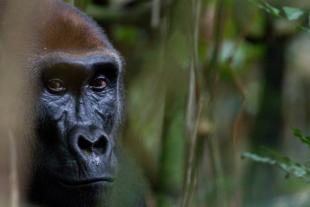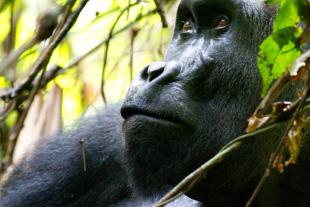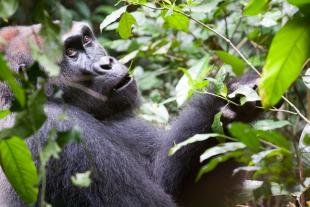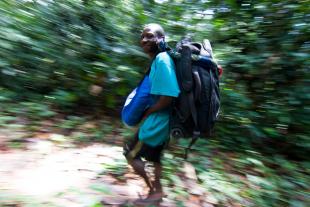You are here
Standing Naked in the Congo
‘Think, think, what was it he’d said? Ah yes, that was it. When they charge at you don’t show any fear. Okay, remember, no fear, no fear. Hmmm, that’s not working. I’m scared. I don’t want to be standing here anymore’.
Ever since I was a small boy listening to tales of my fathers’ childhood in Africa or watching the latest David Attenborough wildlife documentary I’d dreamt of this moment. Finally it was happening and yet I was no longer sure I wanted to be here.
I was stood in my underpants, stuck in the thigh deep, gooey, clinging mud and stagnant waters of a swamp in the jungles of the Congo. I could wave my arms about like a mad bird learning to fly, but the mud, which was acting like concrete trousers, was holding me fast. My attacker was having no such forward momentum problems as he came hurtling through the forest undergrowth and splashed at speed through the swamp towards me. He was, I tried to remind myself, merely putting on an act in order to show who was boss. He needn’t have bothered. As I tried to calculate how long it would take him to tear my arms out of their sockets I came to the conclusion that I had no qualms about accepting his authority.

The Congo. The very name conjures up a sweltering jungle populated by chest-thumping gorillas. The way the word rolls off the tongue immediately brings to mind the sound of beating bongo drums and images of paddle-wheel steamers sailing down mud-brown rivers a mile wide. But wait, isn’t the Congo also the bleeding heart of Central Africa? Isn’t it a place of uncontrollable militias? A place of rape and pillage, corruption and ethnic slaughter? Yes and no. You’re thinking of the Democratic Republic of Congo and even here the commonly held clichés of the Congo are only a half-truth. But I’m not talking of the DR Congo. I’m talking about its far smaller neighbour, the Republic of Congo. This French-speaking country on the west coast of Central Africa is the forgotten Congo and though it too has gone through some rough patches in the past, today it stands on the cusp of a new era. It’s got oil, it’s got timber, it’s got a rapidly expanding infrastructure and what’s more it’s safe and stable. It also has a stash of national parks and other protected areas covering enormous swathes of barely touched rainforest filled with the calls of great apes and lumbering elephants. There’s no shortage of rainforest in the Congo; some 60% of the country consists of nothing but steamy lowland jungle that is so pristine that the rainforests here are considered some of the richest and most biologically important forest ecosystems on Earth. Some years ago National Geographic magazine ran an expedition to survey the forests of northern Congo. During the course of their work they encountered groups of chimpanzees whose curious reaction to seeing human beings led the scientists on the expedition to conclude that these chimps had never before seen people. They also encountered lowland gorillas and forest elephants. Not one or two, not even dozens of them, but hundreds. When the story of their expedition was published National Geographic writers simply described northern Congo as ‘the worlds last Eden’. High praise indeed, and it was the thought of exploring such a rainforest that had brought me, and a slowly increasing number of other trail blazing travellers to Congo.
My journey hadn’t started in Tarzan thick jungles though, but rather on the soft Atlantic sands of Pointe-Noire. This was a very different kind of Congo. An oil and trade port city, with a hint of a beach resort, populated by expatriates from across Africa, the Middle East, Europe and America. Don’t get me wrong it’s no Dubai, but it’s about as close as Central Africa gets. After a day or so coming to terms with being in Congo I travelled north up the coast to the Parc National Conkouati-Douli. Like Pointe-Noire this national park defies Congolese expectations. Sure, there are patches of forest here, and one day, whilst my guide and I paddled a kayak down a tar coloured river, we even caught a fleeting glimpse of a gorilla rushing off through the undergrowth, but the dominant landscapes here consist of coastal lagoons, surf beaten beaches and savannah grasslands grazed by rusty-red buffalo. Aside from the buffalo the big attraction of this park are the turtles which on moonlit nights clamber ashore to lay eggs, but they weren’t the only ones to enjoy these peaceful beaches. According to Louis-Philippe Lévesque, a representative of the Wildlife Conservation Society (http://congo.wcs.org), who manage the park alongside the Congolese government, the waves that roll ashore in Conkouati-Douli are also popular with surfers. But by surfers he didn’t mean bronzed Hawaiians, but rather bulky hippos that, according to Lévesque, spend the cool early mornings riding waves! If that weren’t enough a wildlife excitement the park also contains a chimpanzee rehabilitation sanctuary where travellers can see young chimps, orphaned due to poaching, being reintroduced to life in the wild.

Sadly, my time in Conkouati-Douli was up before I got a chance to see the hippos hanging ten. Returning by bumpy road to Pointe-Noire I flew north to Brazzaville, the Congolese capital. Brazza, as it’s commonly known, sits on the banks of the mighty Congo River which at this point in its journey looks more like a muddy ocean channel than a mere river. On the opposite side of the river is the sprawling megalopolis of Kinshasa, capital of the DR Congo. The two cities could not be any different. Where Kinshasa spreads through miles of shell-shocked concrete monotony, Brazzaville is low-key and village-like. Kinshasa demands you to be street savvy, Brazzaville demands you to stop for coffee at a pavement café. A more easy-going and likeable Central African city it would be hard to find. My time here was spent sitting on the terraces of French restaurants and gazing across the river to the bright lights of Kinshasa, rummaging though the city’s’ many markets and checking out the striking art scene at the École de Peinture de Poto-Poto (Ave de la Paix). But pleasant as it was, dining in French restaurants was not my reason for coming to the Congo. I was here for the jungle and in particular the 23,500sqkm Parc National Nouabalé-Ndoki. Located in the far northwest of Congo, this vast region of swampy forest is truly the world before the chainsaw and is home to healthy populations of western lowland gorillas, forest elephants, chimpanzees and more. And what makes this park so enthralling is the ease with which these creatures are seen. There’s plenty of opportunities for guided forest walks here, but what this park is best-known for is its natural clearings in which elephants, gorillas, buffalo, forest hog and more gather. Overlooking some of these clearings the Wildlife Conservation Society, who as in Conkouati-Douli share responsibility for the park with the Congolese government, have built viewing platforms from which visitors can get an unheralded view of Congolese megafauna.
My journey from Brazzaville to Nouabalé-Ndoki had taken an exhausting, but never less than fascinating, three days of hard overland travel by bus, a very battered taxi, boat and foot. When I finally arrived it was late in the evening and I was shown directly to my large and sparsely furnished safari tent. Lying on my camp bed, listening to the thunderous insect orchestra outside, I slept in fits and starts. When dawn came there was a knock on my tent door, “Monsieur, it’s time. Let’s go”. Ten minutes later I was following in the footsteps of my guide. He seemed to float with speed and grace through the forest. By contrast I slipped and fell with all the elegance of an elephant on an ice-rink. The forest became denser, almost menacing. My guide paused to look at some broken saplings and then pointed ahead, “This way”, he said and hacked his way through thick, thorny undergrowth. Without warning the vegetation stopped. We had come to a dark, peat coloured swamp.
My guide pointed to the swamp waters, “They’ve gone that way” he whispered, “Let’s go. Take off your shoes and trousers and we’ll follow them”. I did as commanded. Adrenaline was racing through my body, my chest was tight with excitement. I could smell their presence. I knew they were close. My eyes scanned back and forth across the undergrowth surrounding the swamp waters. Any moment now I thought and we’ll see them. And that was how, a second later, I found myself standing in my underpants in a Congolese swamp, frozen in fear, as a huge western lowland gorilla came tumbling out of the forest and hurtled towards me.

If You Go There are no direct flights between Dubai and Brazzaville, Ethiopian Airlines (www.flyethiopian.com) offer the most convenient connections. Return flights with Ethiopian cost around US$1300 (Dh4775) including taxes. To visit Nouabalé-Ndoki or Conkouati-Douli national parks it is essential to reserve at least a month in advance through the Wildlife Conservation Society (http://congo.wcs.org; rollabeg@yahoo.fr). A safari in either of these national parks is far from luxurious – potential visitors should be prepared for long days of travel in often uncomfortable conditions. These are genuine wilderness areas. If this doesn’t sound like your idea of fun then the highly regarded Wilderness Safaris (South Africa + 27 11 807 1800; www.odzala-kokoua.com; 6 night all inclusive package s/d US$9416/11,770) have recently started operating exclusive fly-in safaris with accommodation in chic-rustic lodges to the newly revamped Parc National d’Odzala. Activities on offer here include tracking habituated gorilla families and visits to forest clearings to see elephants, buffalo and all the rest. Visas for most nationalities should be obtained in advance.

This article originally appeared in UAE based newspaper, The National, in June 2013. The online version can be seen here: http://www.thenational.ae/lifestyle/travel/take-a-walk-on-the-wild-side-in-congo






